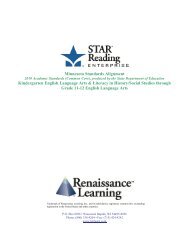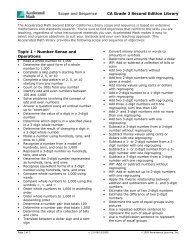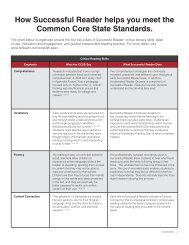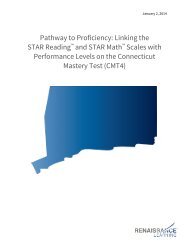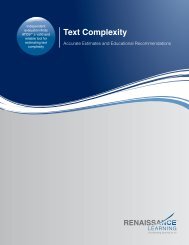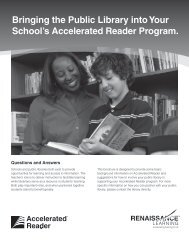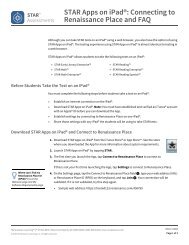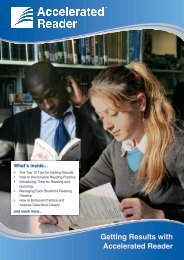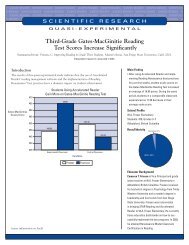Technical Manual - Renaissance Learning
Technical Manual - Renaissance Learning
Technical Manual - Renaissance Learning
You also want an ePaper? Increase the reach of your titles
YUMPU automatically turns print PDFs into web optimized ePapers that Google loves.
IntroductionDesign of STAR Early Literacy Enterpriseachievement longitudinally, facilitating the kind of growth analysis recommendedby state and federal organizations. <strong>Renaissance</strong> <strong>Learning</strong> Tier 2 programs includeSTAR Early Literacy Enterprise, STAR Math, STAR Math Enterprise, STAR Reading,and STAR Reading Enterprise.Tier 3: Summative AssessmentsSummative assessments provide quantitative and qualitative data in the form ofhigh-stakes tests. The best way to ensure success on Tier 3 assessments is tomonitor progress and adjust instructional methods and practice activitiesthroughout the year using Tier 1 and Tier 2 assessments.Design of STAR Early Literacy EnterpriseSTAR Early Literacy Enterprise is the latest version of STAR Early Literacyassessments. While it improves on previous versions in a number of ways, it alsoretains many features of the previous versions. One of the fundamental designdecisions concerning STAR Early Literacy involved the choice of how to administerthe test. The primary advantage of using computer software to administer STAREarly Literacy tests is the ability to tailor each student’s test based on his or herresponses to previous items. Paper-and-pencil tests are obviously far differentfrom this: every student must respond to the same items in the same sequence.Using computer-adaptive procedures, it is possible for students to test on itemsthat appropriately match their current level of proficiency. The item selectionprocedures, termed Adaptive Branching in STAR Early Literacy, effectivelycustomize the test to each student’s achievement level.Adaptive Branching offers significant advantages in terms of test reliability, testingtime, and student motivation. Reliability improves over paper-and-pencil testsbecause the test difficulty matches each individual’s performance level; studentsdo not have to fit a “one test fits all” model. Most of the test items that studentsrespond to are at levels of difficulty that closely match their achievement level.Testing time decreases because, unlike in paper-and-pencil tests, there is no needto expose every student to a broad range of material, portions of which areinappropriate because they are either too easy for high achievers or too difficultfor those with low current levels of performance. Finally, student motivationimproves simply because of these issues—test time is minimized and test contentis neither too difficult nor too easy.Another fundamental design decision concerning STAR Early Literacy involved thechoice of the content and format of items for the test. Its content spans threedomains and ten sub-domains of early literacy skills and abilities, ranging fromgeneral readiness to vocabulary, and includes four of the five key areas of readingSTAR Early Literacy<strong>Technical</strong> <strong>Manual</strong>4





